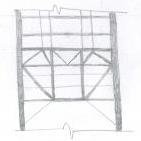-
Welcome to SEFP!
Sefp Consistent Design
-
Similar Content
-
Recent Discussions
-
Latest Forum and Club Posts
-
AA. Usage pf Circular Hollow Sections (CHS), Rectangular Hollow Sections (RHS) & Square Hollow Sections (SHS) is very common in steel construction industry, for Parking Sheds, canopies, etc. A brochure containing reliable structural information regarding the sizes, dimensions & weights of CHS, RHS & SHS available in Pakistan, can be very useful for local structural engineers dealing with structural steel design. Download link of Such a brochure, listing hollow sections conforming to several ASTM & other standards, is being shared here for the benefit of all those interested. Regards.
-
By MalikMemon004 · Posted
I am designing a G+2 factory building founded on dense sandy soil as per our geotechnical investigation report. Load considered: (As Client was not sure about the purpose of use) Live Load on Slab= 3.0 kN /m2 Dead Load on Slab= 1.5 kN/m2 (other then Self weight) Grid Spacing: 27'9"x21'3" Plot Dimensions: 56'x165' Characteristic Load on Columns: (decisive case) Dead Load: 1900 kN Live Load: 950 kN The report recommended bearing capacits: Isolated Footing: 160 kPa at 2.0m depth Settelment within 25 mm Raft foundation 300 kPa at 2.0 m below existing ground level (EGL), With the column loads of around 2800 kN and grid spacing isolated footings would require very large foundation sizes leaving little or no clearance between footings and cause overlap issues. Therefore i decided to go for raft foundation. However, the site condition is such that: The EGL (existing ground level) in the report corresponds to be the site’s current level +0.0 m, while the outer road level is about +0.9 m higher. Our finished factory floor will be at +1.5 m. Now i am evaluating two options: Option A – Construct the raft foundation at the recommended -2.0 m below EGL (per the GI report), then build up columns, cast a plinth beam at the raised level, backfill up to the required ground/floor level, and finally prepare a floor over the compacted backfill. Option B – Raise the site to match the road level using engineered, well-compacted backfill, and then construct the raft foundation directly at the new raised ground level, allowing the raft slab itself to serve as the factory floor. I want to understand: Which option is more technically sound and economical considering bearing capacity, settlement control, and long-term performance? Is placing the raft on engineered backfill (Option B) acceptable practice if compaction and quality control are ensured, or is it safer to strictly follow the geotechnical recommendation (Option A)? Any insights or experience-based advice on this choice would be highly appreciated. Furthermore: Are the load assumed too conservative? Kind Regards Abdul Malik -
By Zain Saeed · Posted
ETABS has various options i.e., Diaphragm Max over Avg Drifts, Story Max over Avg Displacements, Story Max over Avg drifts (Go to display tables> analysis results> joint output> displacement> the options area available here) I noticed some people do this torsional sensitivity check and calculation of torsional amplification factor (Ax and Ay) based on story drift and not on story displacements... the results from each approach gets different ??? also there is another option with Diaphragm so what's the correct approach ??? and how do we know actually what points ETABS has considered for calculation of max/min displacement or drifts. -
By Zain Saeed · Posted
I am working on a high rise building (overall 69 stories, 10 stories of carpark, transfer slab at level 12) located in a very low seismic zone (PGA 5%g). The building first mode is translational (i considered Ux, Uy and Uz tables for this classification) and 2nd mode is torsional followed by 3rd mode again in translational. The modal mass participation ration as shown below. I considered the default 12 modes and getting the required overall 90 percent mass participation both in X and Y direction (Sum Ux and also Sum Uy) but didnt consider the SumUz or ther SUm Rx,Ry and Rz. Is this important ??? I understand that ideally the first 2 modes should be translational followed by torsional mode and this can be achieved with proper structural distribution of elements on the floor plans however for this building the design was freeze and the design team want to proceed. After the response spectrum analysis, i showed them that the higher reinforcement in column and shear walls are resulting from this torsional behavior in 2nd mode. My question is that we have incorporated additional reinforcement tin these shear walls and columns however the slab diaphragm needs any attention ??? or any other element like designing diaphragm particularly at the transfer level to ensure that it receives this torsion and transfer safely to shear walls and columns ?? -
By Zain Saeed · Posted
I am working on a multi tower building with a common podium (Fig 1). The initial ETABS model wasn't built using multiple tower option however during the seismic design incorporation, i activated this "Multiple tower" option in ETABS and accordingly set podium to T1 and T2 and T3 for the remaining two towers (Fig 2). Afterwards i partially exported the towers and performed the analysis to get story forces from individual tower models. These forces were finally added as user defined seismic load in the full complete model (Fig3) As mentioned above that not to use ELF base shear, i initially thought it shouldn't be an issue. However later after analyzing the complete full model with multiple towers i realized, that it almost showed double base shear from ELF in case we go for automatic seismic load (based on code) compared to manually applying the story forces on the towers (Fig 4). I am not sure if its some modelling mistake and trying to figure out why there is much different in static load case however the response spectrum from both models show minor difference -
By Zain Saeed · Posted
Yes, as the approximate period is simplified and often conservative compared to more accurate one obtained from modal analysis which reflects actual stiffness, mass distribution, and geometry of structure -
By Zain Saeed · Posted
@Wajahat Latif Can you further elaborate on the above point -
By Zain Saeed · Posted
Can share and elaborate the different load combos required for the towers which are resting on a common podium and how these are different in case a seismic joint is there ?? Also what design consideration have to be taken for the diaphragm at top of podium where the towers are resting ??As i believe that out of phase movement for the 2 towers will generate high internal forces at the podium diaphragm. Does ETABS automatically considers them or we need to manually define some combinations for such scenarios ??? -
By mohammed ishaq · Posted
what is our ultimate goal by making reduction in members stiffnesses in softwares ?? i know the concept but i do not know the sense behind this in terms of the practical advantages will get after doing this and what will happen if we did not .
-




.thumb.jpg.700916fbc7ead330085e15745d0270bd.jpg)


Recommended Posts
Create an account or sign in to comment
You need to be a member in order to leave a comment
Create an account
Sign up for a new account in our community. It's easy!
Register a new accountSign in
Already have an account? Sign in here.
Sign In Now